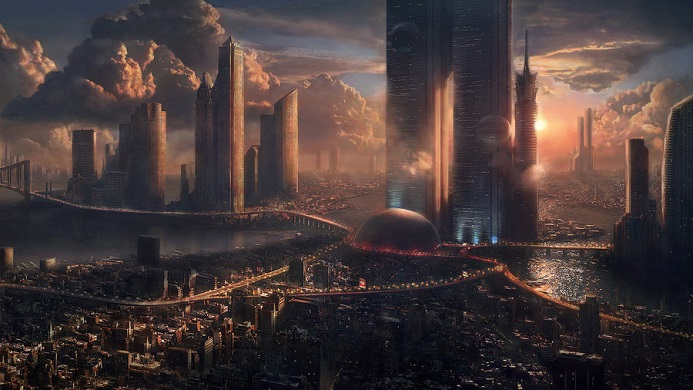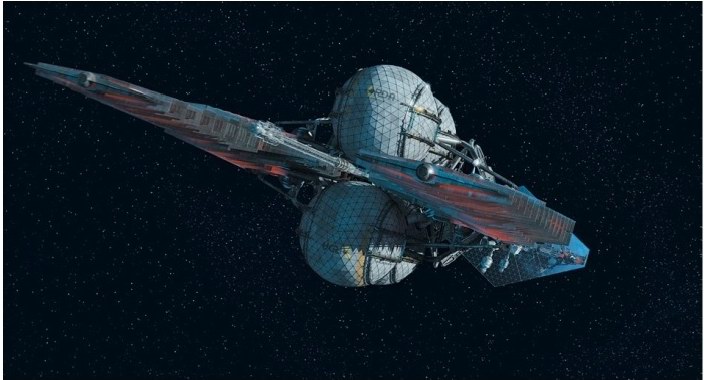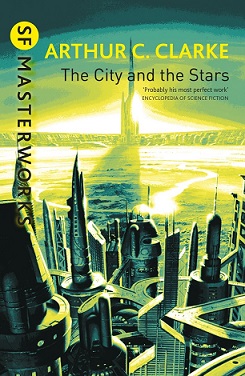Review: The City and the Stars

“When beauty is universal, it loses its power to move the heart, and only its absence can produce an emotional effect.”
In Diaspar, the echoes of the past permeate the present. According to the legends, man had traipsed across the galaxies and conquered the stars. Our spread across the cosmos, aided though it was by technological marvels unfathomed in earlier ages, eventually was terminated by a tragic encounter with an advanced race known only as the Invaders. After a series of devastating conflicts, a Carthaginian peace ensued by which humanity retreated from the stars and promised never to leave Earth again or else risk extinction. Or so the legends claim.
For a billion years the surviving population has lived out its existence in Diaspar — a kind of sprawling, hermetic, techno-spiritual paradise run entirely by computers. The city is self-organizing and self-repairing, with the ability to bathe physical environments in holographic constructs. Only neural signals are required to call up digital, if unfailingly lifelike, projections with which one wishes to interface. Through genetic engineering, humans have further banished aging, the threat of disease, the need for sleep and even the capacity for reproduction, with sex serving only recreational purposes.
In this far-future refuge, immortality through longevity comes at a steep price: the level of control extends down to an individual’s personality and predispositions. Men and women are created by the Central Computer according to templates preformulated by Diaspar’s designers. After living for thousands of years, their physiological “patterns” are moved to the city’s memory banks in order to make room for others. These patterns can then be reconstituted at any time with memories of previous lives and experiences fully intact.
The designers chose to guard their secrets by programming an element of fear into the citizenry. This carefully cultivated, almost pathological dread of the past, is the regulating force that defends against a reconfiguration of the designers’ preset goals.
Like the puppeteering portrayed in Orwell’s 1984, such exhaustive measures have ultimately led to a society in stasis. The people of Diaspar shrink away from any and all thoughts of reasserting the kind of former glory that made room for spaceflight and interstellar voyaging. Diasparians know of only one, last city — their own. Outside the protective dome that closets them, it is fervently believed, lies only barren desert and the rotting remnants of humanity’s merciless defeat at the hands of the Invaders. There is nothing more, and yet the people want nothing more. It is as if curiosity has been bred right out of the human race.
But every once in a long while, Uniques are “born”: individuals with a blank slate and with a set of preferences and impulses that fall outside the usual constraints. One might think of it as the “Red Pill” protocol, a means of shaking things up from time to time. In this cycle, that Red Pill is Alvin, the first of his kind in more than seven thousand years. Unlike his peers, Alvin’s sense of wonder and intrepidity motivate him to buck the stultifying norms of his culture. It isn’t long before he is able to break free from Diaspar’s conditioning and learn the truth about humanity’s past and the world beyond its walls.

I hesitate to share too much more, but it will suffice to say that what Alvin finds in his pursuit of the facts changes the course of Diaspar forever, resulting in a total redraft of the reality they once knew. Welcome to one of Arthur C. Clarke’s first full-length novels, The City and the Stars (adapted from his earlier novella Against the Fall of Night), originally published in 1956.
Acquaintance and Anticlimax
For all of the tension and intrigue in the opening sections, one gets the distinct impression that Clarke burned through his narrative fuel earlier than expected and spent the remainder of the novel trying to make up for it. Once we learn of the true origins of Diaspar and Alvin makes it outside the city, the momentum stabilizes and the plot begins to meander in several unspecified directions without ever quite making it back on the road.
Moreover, Alvin is able to fulfill his deep sense of wonder without so much as a hiccup along the way, and this allows little room for character development. Progress isn’t achieved so much as it merely occurs. Alvin’s escape from the city despite a thousand million years of prior failings is managed within a couple chapters. His trip to the Seven Suns at the other end of the cosmos is intercut with so few obstacles as to make the experience trivial. Other than more insight into what’s “out there”, Alvin and his companion return from the stars no different from when they left.
Though the worlds Alvin visits and the assorted entities he meets are extraordinary and lyrically captured in a way only Clarke can, it’s not clear how they factor into the story you started out reading. We are briefly introduced to an enigmatic machine race that fell victim to religious indoctrination. An extended section in the middle has Alvin caroming from planet to planet and is essentially a distillate of the planet-hopping feature in Mass Effect. A chance encounter on one such world showcases an ambiguously sized creature that is simultaneously omniscient, telepathic and capable of moving at FTL speeds. Interesting as they are in isolation, there’s little working in the background to tie these threads together.
Might Sir Clarke have realized this himself and decided to let the story peter out? At one point he seems to channel this sentiment through his main protagonist:
“When I first left Diaspar, [Alvin] said, “I did not know what I hoped to find. Lys would have satisfied me once — more than satisfied me — yet now everything on Earth seems so small and unimportant. Each discovery I’ve made has raised bigger questions, and opened up wider horizons. I wonder where it will end…” (p. 190)
I, too, wondered how it would all end and felt let down when the big bang of an ending I craved never came. So much time is spent in rote, context-free exploration, too little time moving the story forward. Equally frustrating is that the many disparate elements of the story are never internally resolved or even satisfactorily explained. What were the fruits of the other fourteen Uniques who came before Alvin; did they accomplish nothing? What was the fate of the waggish Jester? Who was and what became of the “Master”, and were the “Great Ones” entirely fictional? The concluding pages are silent on these questions and instead uncork a steady stream of additional mysteries that fail to clarify the muddled story line.
Closing Thoughts
Arthur C. Clarke famously remarked, “Any sufficiently advanced technology is indistinguishable from magic.” In The City and the Stars, we are treated to a world brimming with a technological vision guaranteed to make even the fussiest of sci-fi fans gush — from virtual reality and AI to interstellar travel and bioengineering. While much of the futurism is still inconceivable today, Clarke was ahead of his time in many ways, particularly with respect to the level of control humans have invested in computers and machines. You may find yourself, as I did, periodically checking the front flap to confirm it was indeed written in the 50s, before the most basic computers existed.
If only Clarke had reined in his potent imagination to focus more on refining the narrative, this volume might be considered a masterpiece of the genre. His panoply of inspirations unfold in rapid-fire fashion — like a series of “and then” moments strung together — with little regard for overall coherence. Too much of the plot is too nebulously described, and Clarke fails to carry the entertainment level of the first half of the book through to the end. With no small irony, it’s the point at which humans return to the stars that the story begins to flag. The City and the Stars is still a good place to glimpse Clarke’s literary talents that come of age in Rendezvous with Rama and Childhood’s End, but the near-biblical prose isn’t enough to rescue the disjointed plot, uneven pacing and weak characterization.
The faults notwithstanding, Clarke’s interest is in the big ideas, and he gives us something as relevant to ponder today as it was sixty years ago: where are we headed with technology, what do we want from it, and how should we use it?
Note: This review is mirrored over at Goodreads and at Amazon.



Comments